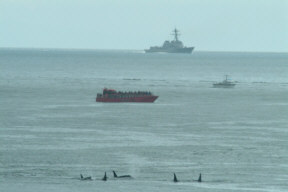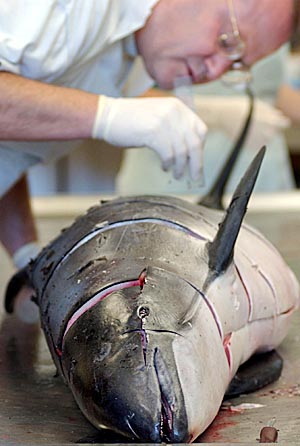
 |
|
| Home | Our Research | Luna / L98 | Active Sonar | Donate & Act Now | About Us | |
|
Active Sonar (including LFAS - Low Frequency Active Sonar) is a set of anti-submarine technologies which emit
very loud pulses of sound
into the ocean, and then listen for echoes in order to paint
a snapshot picture of all objects within their range.
Click here for an overview of Active Sonar....
The US Navy has stated that have "developed complex and costly measures to minimize risks to marine mammals" and that they "investigated the possiblity that there could be something in the structure of the LFA signal that posed a special risk for behavioral disruption in marine mammals." "Although some responses were measured, none of the responses indicated a potential for the disruption of biologically important activities." Click here for source... However, the following articles document instances all over the world where whales have died on the same day that US and NATO Navy forces utilized active sonar nearby. |

photo: Petty Officer Donnie Brzuksa -- U.S. Coast Guard, via AP |

photo: Garden Island -- via AP |
While these news articles present circumstantial evidence and suggest that LFAS or Active Sonar
is responsible for these deaths, we urge you to realize that nearly
all species of whales
are endangered, which means that their chances of
survival - as a species - are already compromised. Human activities such as oil exploration, LFAS
and Active Sonar add weight to their struggle and make it far more difficult for us to
save them from extinction.
As the US Navy progresses with more Active Sonar deployments, the effects upon wild and endangered marine mammal populations becomes more evident to a growing number of witnessess. In the photo to the left, a sunbather watches helplessly while 200 melon-head whales rush towards shore as the US Navy uses sonar in Hawaii. |

photo: Launceston Examiner |
When a whale dies, it almost always sinks. No witnesses.
The news articles above document those few occasions
when dying whales have managed to beach themselves -
providing rare opportunities for us to learn of the Navy's underwater activities.
ANON is dedicating most of its resources to the task of elevating public awareness -- and subsequently applying pressure to the US Congress -- in order to prevent its deployment (at least until adequate research has proved that it is safe). This issue is so important: we urge you to take the time to understand what is at stake. Please, click here to learn more about the science behind active sonar... |
|
The first documented evidence that US Sonar was directly responsible for
whale & dolphin deaths came from the US Navy itself.
This research paper
- a joint report by the US Navy and NOAA - meticulously rules out all other possibilities, and
explicitly states that the cause of this stranding was the Navy sonar.
One of the world's leading orca researchers, Ken Balcomb, was there in the Bahamas when the calls began pouring in of stranded and dead whales all throughout the Bahamas. Tragically, he was a witness to yet another incident: this one was directly in front of his research facility in the San Juan Islands. Read his first-hand account of the effects of Navy Sonar on orca, porpoises and human observers - by Ken Balcomb himself. Initially, the US Navy denied that it's Destroyer had anything to do with the incident, but a recent report from NOAA Fisheries found otherwise. |

photo: Ken Balcomb |
|
Several news agencies devoted coverage recently to another new report, published in the journal Nature, which offers additional evidence that Active Sonar technologies are responsible for the deaths of whales and dolphins. Essentially, researches in England and Spain found that whales who had died on the same day as NATO naval forces were utilizing sonar - died as a result of decompression sickness, or the 'bends'.
|
 photo: AP News |
|||||||||||||||||||||||||
|
Now consider this: we have fossil records showing that many species of whales have been essentially unchanged for over 50 million years. Living and diving in the sea - 24 hours a day - for their entire lives. How is it possible, then, that these whales suddenly 'forget' 50 million years of natural habit, and suddenly rush to the surface of the ocean so quickly that it causes a deadly case of decompression sickness? |
||||||||||||||||||||||||||

| July, 2002 | President George Bush granted an exemption from the Marine Mammal Protection Act & the Environmental Protection Act to the US Navy to deploy LFAS. |
| August, 2002 | The Natural Resources Defense Council filed suit to block the exemption (NRDC Press Release) |
| October, 2002 | The US Federal Court in San Francisco granted the injunction. |
| November, 2002 | The US Federal Court ordered a temporary compromise in which the Navy is allowed to deploy
for testing purposes in a smaller (and hopefully less sensitive) area of the ocean
(MS-NBC Article).
The MSNBC article states "The agreement does not preclude the Navy from using the system to detect modern, quiet submarines during wartime, and acknowledges that the Navy must be allowed to train with it beforehand." What criteria the Navy might use to define "wartime" wasn't specified, and the possibility that the Navy may circumvent the Marine Mammal Protection Act remains a real concern. |
| May, 2003 | The US Navy requests additional exemptions from the Marine Mammal Protection Act & the Environmental Protection Act
under the Fiscal Year 2004 Defense Appropriations Bill. We at ANON strongly believe that this is an inappropriate
use of fiscal policy
What criteria the Navy might use to define "wartime" wasn't specified, and the possibility that the Navy may circumvent the Marine Mammal Protection Act remains a real concern. |
| June, 2003 | On June 30, the NRDC returns to court to argue before Federal Court our cause. The temporary compromise reached in November is nearly at an end, and the Navy wants the right to fully deploy however, whenever and wherever they see fit. |
| November, 2003 | The United States Congress grants all military personnel complete exemption from the Marine Mammal Protection Act.
Read how Congress striped power from environmental laws and what the world's press had to say about it. |
| October, 2005 | A lawsuit was filed in Santa Monica, California on 19 October 2005 contending that the
U.S. Navy has conducted sonar exercises in violation of several environmental laws,
including the National Environmental Policy Act, the Marine Mammal Protection Act,
and the Endangered Species Act.
Click here for the full text of the active sonar lawsuit. |
